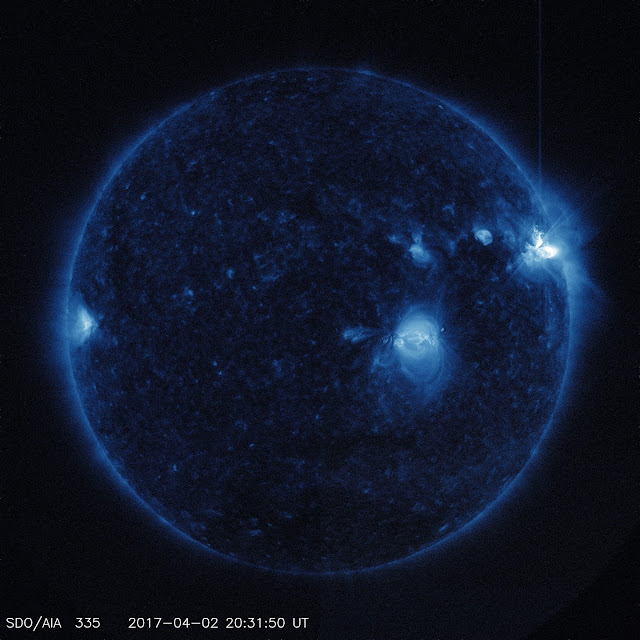NASA - Solar Dynamics Observatory (SDO) patch.
April 3, 2017
The sun emitted a trio of mid-level solar flares on April 2-3, 2017. The first peaked at 4:02 a.m. EDT on April 2, the second peaked at 4:33 p.m. EDT on April 2, and the third peaked at 10:29 a.m. EDT on April 3. NASA’s Solar Dynamics Observatory, which watches the sun constantly, captured images of the three events. Solar flares are powerful bursts of radiation. Harmful radiation from a flare cannot pass through Earth's atmosphere to physically affect humans on the ground, however — when intense enough — they can disturb the atmosphere in the layer where GPS and communications signals travel.
Image above: NASA's Solar Dynamics Observatory captured this image of a solar flare peaking at 4:02 a.m. EDT on April 2, 2017, as seen in the bright flash near the sun’s upper right edge. The image shows a subset of extreme ultraviolet light that highlights the extremely hot material in flares and which is typically colorized in blue. Image Credits: NASA/SDO.
Image above: NASA's Solar Dynamics Observatory captured this image of a solar flare peaking at 4:33 p.m. EDT on April 2, 2017, as seen in the bright flash near the sun’s upper right edge. The image shows a subset of extreme ultraviolet light that highlights the extremely hot material in flares and which is typically colorized in blue. Image Credits: NASA/SDO.
Image above: NASA's Solar Dynamics Observatory captured this image of a solar flare peaking at 10:29 a.m. EDT on April 3, 2017, as seen in the bright flash near the sun’s upper right edge. The image shows a subset of extreme ultraviolet light that highlights the extremely hot material in flares and which is typically colorized in teal. Image Credits: NASA/SDO.
To see how this event may affect Earth, please visit NOAA's Space Weather Prediction Center at http://spaceweather.gov, the U.S. government's official source for space weather forecasts, alerts, watches and warnings.
Solar Dynamics Observatory or SDO. Image Credit: NASA
The first April 2 flare was classified as an M5.3 flare, while the second April 2 was an M5.7 flare. The April 3 flare was classified as an M5.8 flare. M-class flares are a tenth the size of the most intense flares, the X-class flares. The number provides more information about its strength. An M2 is twice as intense as an M1, an M3 is three times as intense, etc.
Related Link:
NASA’s SDO website: https://www.nasa.gov/mission_pages/sdo/main/index.html
Images (mentioned), Text, Credits: NASA's Goddard Space Flight Center, by Sarah Frazier/Rob Garner.
Greetings, Orbiter.ch





